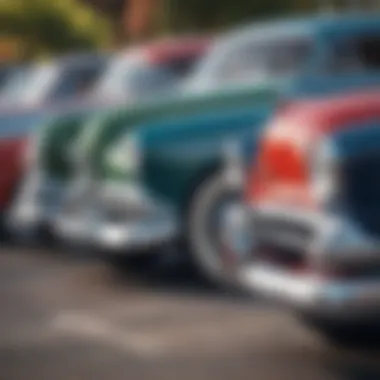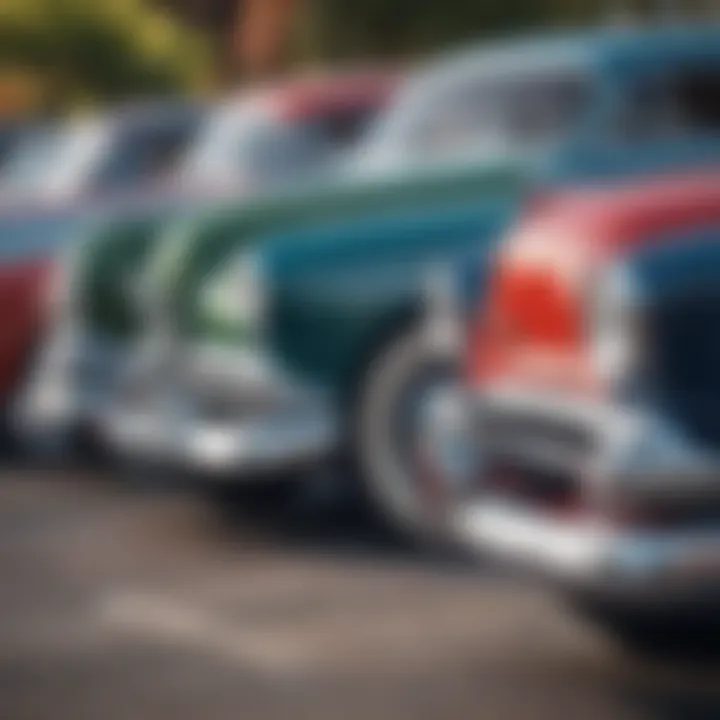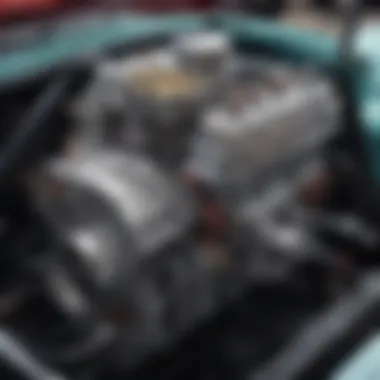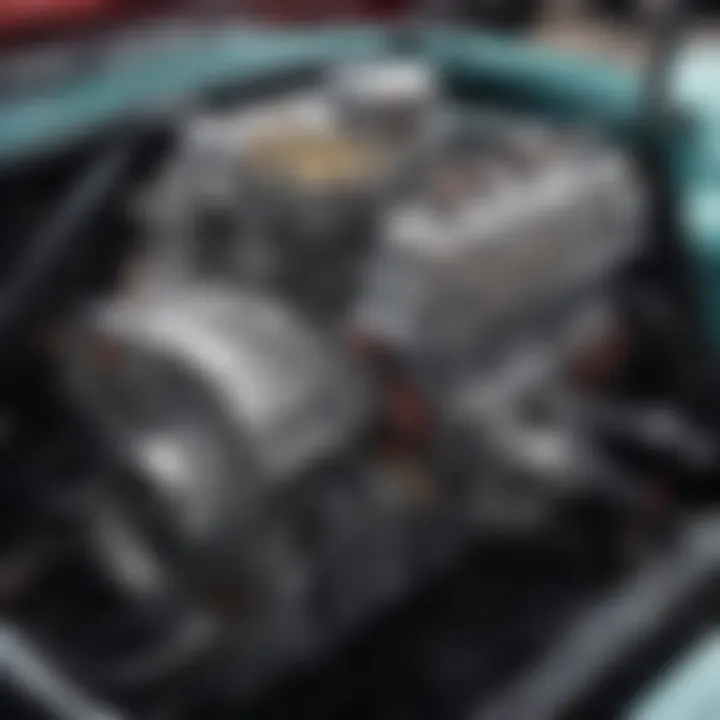A Deep Dive into Classic American Cars


Intro
Old American cars represent more than just vehicles; they are a cultural touchstone, a reminder of a time when craftsmanship and personality defined the automotive landscape. This article navigates the historical significance, design evolution, and cultural impact of these classic automobiles. It will also touch on the intricacies of their mechanics, the vibrant restoration practices, and the current market landscape for vintage models.
Understanding these cars offers insight into not only the technological advancements of their eras but also the shifting preferences of consumers.
Today, old American cars face unique challenges in an industry that increasingly embraces electrification and sustainability. However, their charm endures, making them sought-after collectibles for enthusiasts and prospective buyers alike. This discussion will illuminate the appeal and meaning behind old American automobiles, ensuring readers appreciate why they continue to capture our imagination.
Foreword to Old American Cars
Old American cars hold a unique place in the tapestry of automotive history. They not only represent the ingenuity of engineering from a bygone era but also embody the cultural values and societal shifts that define their time. This section aims to highlight the significance of these classic vehicles, delving into specific elements that contribute to their lasting appeal.
The fascination with old American cars transcends mere nostalgia. For many enthusiasts, these vehicles symbolize freedom, innovation, and the spirit of adventure that characterized the era of their production. Brands like Ford, Chevrolet, and Cadillac produced models that have become icons, recognized not just for their performance but also for their artistry in design.
Moreover, understanding the historical context of these cars allows us to appreciate their engineering. Old American cars were often powered by robust engines and designed to provide a sense of luxury and power, features that are nostalgic for many. The automotive industry underwent significant transformations in the mid-20th century, particularly during the post-war boom, which not only influenced car design but also consumer attitudes toward ownership and mobility.
Benefits of Studying Old American Cars
- Cultural Insight: These vehicles serve as artifacts that reflect the culture and economy of their time.
- Engineering Appreciation: Analyzing the mechanics offers insight into the innovation processes of past auto manufacturers.
- Investment Value: Understanding the market trends may help buyers make informed decisions when collecting or restoring these classic pieces.
In summary, the exploration of old American cars is more than a study of machinery; it is an examination of human creativity, historical context, and cultural significance. Through this article, readers will uncover the depth of this fascinating topic, gaining an understanding of why these automobiles continue to captivate collectors and enthusiasts alike.
Historical Context
Understanding the historical context of old American cars is essential for appreciating their significance in the automotive landscape. Each era brought unique innovations, cultural shifts, and responses to social needs. The evolution of these vehicles reflects broader trends in American society, economy, and technology. Moreover, they serve as a lens through which one can observe changes in consumer preferences and industrial advancements.
Pre-War Era
The pre-war era laid the groundwork for what would become a booming automotive industry. Spanning from the early 1900s until World War II, this period was marked by the introduction of assembly line production, notably exemplified by the Ford Model T. The Model T made car ownership accessible to the average American, revolutionizing transportation. Prior to this, automobiles were a luxury, primarily for the wealthy.
As demand grew, manufacturers began experimenting with various designs and technologies. Innovations such as electric starters, hydraulic brakes, and improved suspension systems started to emerge. These changes improved safety and comfort, enhancing the overall driving experience. The rise of brands like Cadillac and Buick signified the burgeoning luxury market, leading to a diverse range of vehicles catering to different classes of consumers.
Post-War Boom
Following the Second World War, America witnessed an unprecedented economic expansion. The post-war boom produced a surge in automobile production driven by returning veterans and a burgeoning middle class craving for freedom and mobility. This period heralded the emergence of the "big three" automakers: General Motors, Ford, and Chrysler, who dominated the market.
Cars in this era were vastly different from their predecessors. They featured flashy designs, chrome detailing, and powerful V8 engines that appealed to a new generation of buyers. The Chevrolet Bel Air and Ford Thunderbird became cultural symbols of this prosperous time. This era also introduced innovations like automatic transmissions and power steering, making the cars easier to drive than ever before. With the construction of the interstate highway system, long-distance travel became a reality, further entwining cars with American identity.
The Muscle Car Era
The muscle car era, spanning the late 1960s to the early 1970s, marked a peak in American automotive culture. This time was characterized by the production of high-performance vehicles designed for speed and power. Cars like the Ford Mustang, Dodge Charger, and Pontiac GTO became icons, representing youthful rebellion and an insatiable desire for performance.
Automakers capitalized on this trend, developing models that boasted rising horsepower figures and aggressive styling. The market also saw a demographic shift; younger buyers eager for excitement became the focus. However, this was a double-edged sword, as the oil crisis of the 1970s led to a decline in demand for gas-guzzling vehicles. Consequently, the muscle car era came to a crashing end, making way for a new focus on fuel efficiency and practicality in automobile production.
"Each era of American cars not only reflects technological advancements but also mirrors the cultural zeitgeist of its time."
This historical context of old American cars provides a foundation to understand their design and significance, leading into the subsequent exploration of iconic models and the mechanics behind classic vehicles.
Iconic Models of the Past
The significance of iconic models in American automotive history cannot be understated. These vehicles represent more than just modes of transportation; they embody innovation, cultural shifts, and unique design philosophies that defined their respective eras. In this section, we will explore three noteworthy models that stood out and left lasting impressions—each uniquely influencing car enthusiasts while contributing to the evolution of the automotive industry itself.
Ford Model T
The Ford Model T is often regarded as the vehicle that transformed America. Launched in 1908, it was the first automobile mass-produced on assembly lines using interchangeable parts. This innovation drastically reduced its cost, making it accessible to the average American. More than just a car, the Model T symbolized mobility and the American Dream.
- The Model T was powered by a 2.9-liter inline-four engine, producing a modest 20 horsepower. However, its lightweight design allowed it to achieve speeds up to 45 miles per hour.
- It offered simplicity in both design and maintenance. Most parts could be repaired with basic tools. This ease of use helped promote a growing automotive culture.
Owning a Ford Model T became a rite of passage for many families, shaping not only personal narratives but also societal expectations.
Chevrolet Corvette
Introduced in 1953, the Chevrolet Corvette has become an enduring symbol of American performance and style. Often called the "American sports car," this model reflects the post-war shift towards greater consumerism and leisure.
- The Corvette was notable for its fiberglass body, a major departure from traditional steel. This innovation allowed for lighter weight and unique styling.
- The early models featured a 150 horsepower inline-six, which later evolved into powerful V8 engines in subsequent models.


The Corvette has frequently graced racetracks and roads alike, embodying speed and freedom. Its associations with pop culture and racing have solidified its status as a sought-after collector's item.
Cadillac Eldorado
Launched in 1953, the Cadillac Eldorado quickly became synonymous with luxury and opulence in American automobiles. It set standards for what a luxury car should represent, combining powerful engineering with a stylish design.
- The Eldorado featured distinctive fins and elaborate chrome detailing, embodying the design trends of the 1950s.
- With a V8 engine capable of producing upwards of 200 horsepower, the Eldorado was designed for comfort and performance, often described as a status symbol among the affluent.
Throughout the decades, the Cadillac Eldorado maintained its reputation for luxury while continually evolving its design and features. It remains a noteworthy example of America's manufacturing prowess and luxurious inclination in the automotive industry.
"These iconic models have not only paved the way for their successors but have also shaped the identity of American automotive culture."
These vehicles provide insights into the evolution of design and consumer expectations, illustrating how cars have become key elements of American heritage.
Design and Aesthetics
The design and aesthetics of old American cars represent a blend of creativity, artistry, and engineering that has significantly influenced the automotive industry. This section focuses on various elements that contribute to the visual appeal and overall character of these classic vehicles. Each facet of design not only enhances the car's look but also reflects the era it was built in, showcasing technological advancements and cultural trends. Crafting a vintage car is an intricate process that encompasses shape, style, and detail as its key elements.
Art Deco Influence
The Art Deco movement, which flourished in the 1920s and 1930s, left an enduring mark on automotive design. This style is characterized by its bold geometric shapes, vibrant colors, and luxurious materials. In old American cars, the influence of Art Deco is seen in the elegant contours and ornamentation that adorn their bodies.
For example, the Chrysler Airflow was revolutionary due to its streamlined shape and distinctive features. Its integration of Art Deco elements served not only an aesthetic purpose but also a functional one, as it assisted in reducing drag. This era characterized American automobiles that were not just modes of transport, but symbols of status and prestige, reflecting the richness of the Art Deco style.
Streamlining in Design
Streamlining played a pivotal role in defining the aesthetics of many old American cars, particularly during the 1930s. This approach aimed to enhance performance while also attracting consumers with sleeker, more aerodynamic shapes. The design philosophy behind streamlining involved creating forms that reduced air resistance, thus improving fuel efficiency and overall speed.
Notable examples include the Ford Thunderbird and the Chevrolet Bel Air. These vehicle models are marked by smooth lines and flowing surfaces. Furthermore, this style contributed to the futuristic look that captivated many car enthusiasts.
Key Characteristics of Streamlined Design:
- Sleek Profiles: Emphasizing elongated shapes that taper toward the back.
- Integrated Details: Headlights, bumpers, and taillights are designed to blend seamlessly into the body.
- Functional Elegance: High attention to aerodynamic principles that enhance both aesthetics and performance.
Color and Detailing
Color and detailing are essential components of car aesthetics, creating an immediate impact on first impressions. In the era of old American cars, vibrant and bold colors were often used to showcase individuality and appeal to the consumer's sense of style.
Cars were painted in various striking colors, from deep reds to soft pastels, and detailed with chrome accents that highlighted their design features. The elastic nature of paint technology during this period allowed for a diverse palette, with manufacturers experimenting with metallic finishes and elaborate patterns.
Detailing Techniques Include:
- Pinstriping: Fine lines painted along the edges of the car, enhancing its profile.
- Chrome Plating: Used on bumpers, grilles, and other ornamental elements to provide a striking contrast.
- Interior Detailing: Rich fabrics and wood trims in the interiors added luxurious touches that complemented the car's exterior.
"The interplay of color and fine detailing on old American cars speaks volumes about the artistry involved in their design. Each element tells a story of a bygone era, where craftsmanship was paramount."
The design and aesthetics of old American cars are essential in understanding their lasting appeal and significance. These visual elements not only make them memorable but also connect them to a cultural legacy that still resonates today. Each line, color, and detail showcases the evolution of automotive design and reinforces the intrinsic value of these classic vehicles.
Mechanics of Old American Cars
The mechanics of old American cars is a crucial aspect of understanding their enduring appeal. Each component plays a role in the overall performance and character of these classic vehicles. Enthusiasts and potential buyers often look beyond just aesthetics; they seek mechanical reliability and historical significance. This section will explore significant mechanical elements, such as engine types, transmission systems, and suspension systems, providing insight into why they matter.
Engine Types
Old American cars feature various engine types, reflecting the technological advancements of their time. Common types include inline, V, and flat engines. Inline engines, often found in smaller cars, are known for their simplicity and efficiency. V engines, however, dominate the muscle car era and are appreciated for their power and performance. Flat engines, though less common, contributed to the low center of gravity, enhancing handling.
Benefits of Understanding Engine Types:
- Performance Insight: Knowing the engine type helps gauge the overall performance of the car.
- Maintenance Needs: Different engines have various maintenance requirements.
- Historical Relevance: Recognizing engines gives context to the era they originated from.
Transmission Systems
Transmission systems are essential for transferring power from the engine to the wheels. Old American cars primarily featured two types: manual and automatic transmissions. Manual transmissions allow for greater driver control and engagement. Many enthusiasts prefer them for the driving experience they offer. On the other hand, automatic transmissions provide ease of use, making driving more accessible for many.
Considerations for Transmission Systems:
- Driver Preference: Choosing between manual and automatic usually depends on personal driving style.
- Maintenance Complexity: Manual systems may require more attention, while automatic systems often need specialized knowledge for repairs.


Suspension and Handling
The suspension system plays a vital role in how a car handles and rides. Classic American cars typically utilize either leaf spring or coil spring setups. Leaf springs were common in older models while coil springs became popular later due to enhanced comfort and handling. The type of suspension directly influences the driving experience, impacting everything from ride comfort to handling performance.
Understanding suspension types is key for anyone considering restoration or purchase.
Main Elements of Suspension Systems:
- Comfort: A good suspension system ensures a smooth ride.
- Handling: The handling of a vehicle depends greatly on its suspension configuration.
- Durability: Different materials and designs can impact the longevity of the suspension components.
Maintenance and Restoration
The maintenance and restoration of old American cars play a vital role in preserving their historical significance and ensuring they can be appreciated for generations. As these vehicles age, proper care becomes essential to maintain their value and performance. Collectors and enthusiasts must be well-informed about basic upkeep routines, sourcing authentic components, and the challenges they may encounter during restoration. Understanding these elements allows for a much more fulfilling experience with vintage cars.
Basic Maintenance Tips
One of the key aspects of maintaining old American cars is routine checks. First, regular oil changes are crucial as they help to keep the engine running smoothly. It is advisable to change the oil every 3,000 miles or sooner if the car shows signs of wear.
- Check the tires frequently. The tread depth should be adequate, and the air pressure should be maintained according to the manufacturer's specifications.
- Always inspect the brake system. Old vehicles may have weaker braking power, so pads and fluid must be monitored closely.
- Keep the battery terminals clean and ensure there are no corrosion issues. If battery performance is declining, a replacement may be necessary.
- Lastly, undergo periodic inspections of belts and hoses for any signs of wear such as cracks or fraying.
Taking these steps will greatly improve the longevity of classic automobiles.
Finding Authentic Parts
Finding authentic parts for vintage cars is often seen as a daunting task. However, there are several effective strategies collectors can employ to locate the necessary components without much hassle.
First, joining forums or online communities dedicated to specific brands, like those found on Reddit or Facebook, can yield valuable leads on where to find parts. Enthusiasts often share their experiences and recommendations, contributing to a wider pool of information. Websites like eBay or specialized parts suppliers can be excellent sources as well.
It is crucial to authenticate the parts before making a purchase. Original equipment manufacturer (OEM) parts are ideal as they ensure compatibility and reliability. Additionally, some companies specialize in reproduction parts that closely mimic the originals, but caution is necessary since quality can vary significantly.
Challenges in Restoration
Restoration projects can pose numerous challenges, which often require both patience and expertise. One common issue is sourcing the right parts. As old cars become rarer, finding specific components can become increasingly difficult, leading to delays and escalating costs.
Furthermore, the technical aspects of restoration can be daunting. Many owners may not have the skills to address engine rebuilds or bodywork. Engaging a professional restorer can be essential; however, this often adds significantly to the overall expense of the project.
Financial considerations also play a crucial role. Most restoration projects can exceed initial budgets, especially when unexpected repairs arise. Therefore, having a realistic financial plan before starting is advisable.
"Engaging in restoration not only brings classic cars back to life but also fosters a deeper appreciation for automotive history."
As time progresses, the importance of careful maintenance and expert restoration for old American cars remains clear. Ensuring these vehicles are looked after helps preserve their legacy in an increasingly modern automotive landscape.
Collecting Vintage American Cars
Collecting vintage American cars transcends mere hobby; it embodies a profound connection to history, culture, and craftsmanship. This section elaborates on the various facets of collecting these iconic vehicles and emphasizes their significance in the broader context of automotive appreciation. Collectors often find that each car carries a unique story, reflecting the era it was produced in. Thus, understanding the past becomes integral to value and desirability.
One of the primary benefits of collecting vintage American cars is the potential for financial investment. Cars from the early to mid-20th century, especially limited editions or models known for their performance, tend to appreciate over time. A well-maintained classic can offer substantial returns, particularly during economic upturns. Additionally, these vehicles can serve as tangible assets that preserve wealth in unstable markets.
However, it is crucial for prospective collectors to approach the market with caution. Understanding the nuances of valuation can significantly affect a collector's experience. Factors such as the model's rarity, condition, and historical significance play pivotal roles in determining market value. A novice collector might easily overlook these elements, leading to poor purchasing decisions.
Understanding Market Value
Market value in the vintage car realm can be dynamic and multifaceted. Several key aspects dictate a car's worth:
- Rarity: Limited production runs typically enhance a car’s appeal.
- Condition: Original, well-preserved vehicles fetch higher prices compared to those needing extensive restoration.
- Restoration Quality: Professional restorations done to factory specifications can also increase value.
- Provenance: A vehicle with a documented history, especially celebrity ownership, tends to command higher prices.
As trends evolve, certain makes and models may experience fluctuations in desirability, thus affecting value assessments. It is essential for collectors to remain informed about market trends and fluctuations, which can be done by attending car shows, joining clubs, or utilizing online forums like reddit.com.
Insurance Considerations
When it comes to insuring vintage American cars, specialized coverage is crucial. Traditional auto insurance often falls short, as these vehicles require tailored policies that recognize their unique value. Key considerations include:
- Agreed Value vs. Stated Value: Collectors should consider policies that offer agreed value coverage, ensuring they are compensated based on a pre-determined value rather than actual cash value.
- Mileage Limits: Many collectors do not drive their cars regularly. Policies might offer better rates with agreed-upon mileage limits.
- Storage and Security: Insurers often require that vintage cars are kept in secured, climate-controlled environments, impacting policy rates and terms.
Understanding these elements helps collectors protect their investment while ensuring they are adequately covered against potential damages or theft.
Joining a Collector Community


Engaging with a collector community can greatly enhance the experience of collecting vintage American cars. Membership in clubs or online forums provides several advantages:
- Access to Expertise: Being part of a community allows collectors to tap into the wealth of knowledge from seasoned enthusiasts, gaining insights on maintenance, restorations, and market trends.
- Networking Opportunities: Connections made through clubs can lead to valuable trades, purchases, or sales, expanding one’s collection.
- Events and Shows: Many organizations host events which offer opportunities for socialization and the chance to showcase vehicles.
Joining platforms such as facebook.com or attending gatherings can enrich a collector’s journey, providing a sense of camaraderie and shared passion for these magnificent machines.
In summary, the adventure of collecting vintage American cars is laden with potential rewards and challenges, making knowledge, networking, and careful consideration pivotal in navigating this captivating world.
Modern Implications
The exploration of old American cars does not merely reside in nostalgia. It intersects with significant modern themes. The advent of technology, particularly electrification, is reshaping the automotive industry. The awareness of environmental issues has invited newer considerations. Thus, understanding these modern implications is essential for enthusiasts and collectors alike.
Impact of Electrification
Electrification represents a major shift in how vehicles function. It transcends traditional gasoline cars, pushing the industry towards sustainable practices. Old American cars, traditionally powered by combustion engines, face challenges in this evolving landscape. However, some collectors see this as an opportunity rather than a setback.
Key points to consider include:
- Retrofitting Options: Some car enthusiasts are adapting vintage models with electric powertrains. This allows for maintaining classic aesthetics while embracing modern technology.
- Market Trends: There is a growing interest in electric vehicles (EVs), causing a possible decline in the demand for fossil fuel-powered classics. Collectors must strategize their acquisitions based on future market behavior.
The impact on restoration practices is noticeable. Electric conversions can increase the complexity of restoration projects. Yet, this merge of past and future can lead to unique hybrid vehicles that meet new standards without losing historical value.
"As society shifts towards sustainability, old American cars can find new life through electrification, blending nostalgia with innovation."
Preservation vs. Innovation
The balance between preservation and innovation is critical. Collectors often find themselves at a crossroads between maintaining originality and integrating contemporary technology. The preservation of classic vehicles is paramount; however, innovation can enhance usability and performance.
In addressing this balance, consider:
- Restoration Authenticity: Many collectors prioritize using authentic parts in their restorations. This maintains historical integrity but may limit performance upgrades available in modern vehicles.
- Performance Enhancements: Integrating advancements, such as improved brakes and suspension, can be appealing. Yet, this can sometimes detract from the authentic experience of driving a classic car.
This dilemma creates a robust dialogue among enthusiasts. While some advocate for preserving every original aspect, others push for modern improvements. Ultimately, both perspectives can coexist; understanding this divide is essential for collectors in today’s evolving market.
Cultural Significance
Old American cars represent more than just automotive engineering; they embody a rich cultural narrative that is deeply intertwined with American history. From their prominent role in the growth of the automobile industry to their presence in popular culture, these vehicles hold significant value. They are often seen as artifacts that reflect the societal changes, economic conditions, and technological advancements of their times.
In Film and Media
The representation of classic cars in film and media cannot be overstated. Movies like "American Graffiti" and "The Fast and the Furious" franchise highlight these vehicles, showcasing not just their aesthetic appeal but also their deep-rooted connections to American lifestyle. The cinematic spotlight has contributed to the allure surrounding muscle cars and vintage models.
These films often utilize cars as symbols of freedom and rebellion, placing them in scenarios that resonate with the desire for independence. The images of sleek lines and roaring engines can evoke memories of a simpler time, thus reinforcing the emotional relationship people have with these vehicles.
"Cars are more than metal and glass; they are extensions of our dreams and ambitions."
Symbol of Freedom
Cars have often been described as symbols of freedom in American culture. In a rapidly changing world, old American cars represent the ability to explore and navigate vast landscapes. The open road is a metaphor for adventure, and classic cars embody the spirit of a generation that celebrated personal freedom. For many, driving a vintage car is not just a mode of transport; it is an experience that connects them to both the past and the possibility of future adventures.
The act of driving a classic car often evokes a sense of nostalgia. These vehicles can transport drivers back to moments of youth, showcasing a lifestyle that values spontaneity and exploration. In this way, old American cars remain integral to personal narratives of freedom and self-discovery.
Influence on American Identity
Old American cars are undeniably tied to the American identity. They have played significant roles in shaping the culture of the United States. Automobiles are icons of innovation, representing post-war optimism and the rise of suburbanization. Car culture reflects American values such as individuality, success, and the pursuit of happiness.
These vehicles tell stories of craftsmanship and American ingenuity. For collectors and enthusiasts, they are not merely machines but embodiments of history. The passion for collecting these cars often brings communities together, fostering connections among enthusiasts. This community aspect further cements their place within American culture.
In summary, old American cars are significant cultural artifacts. They resonate within film and media, symbolize freedom, and are essential to understanding American identity. Their influence continues to impact the automotive landscape and society as a whole.
Closure
In concluding this exploration of old American cars, it is vital to underscore the significance of these vehicles in both a historical and cultural context. The cars from bygone eras are not mere relics; they represent a profound narrative of innovation, artistry, and the evolution of personal transportation. For automotive enthusiasts and collectors alike, understanding the legacy of these classic vehicles fosters a deeper appreciation for what they have achieved.
The factors contributing to the allure of old American cars include their design aesthetics, mechanical engineering, and the role they play in American culture. Each model tells a story, linking the driver to an era defined by distinct characteristics. Moreover, the ongoing interest in preservation practices and restoration techniques highlights a commitment to honoring this automotive history.
"Old American cars serve as a reminder of the ingenuity and creative spirit that shaped the automotive industry."
Additionally, the market dynamics show a growing value in vintage automobiles, as collectors recognize their significance beyond just monetary worth. With considerations for insurance and community engagement, collectors gain insights into maintaining the integrity of their vehicles and fostering connections with like-minded individuals.
As the conversation around modern electrification and sustainability continues to evolve, the challenge remains to preserve the essence of classic cars while embracing new technologies. Recognizing this balance is essential for enthusiasts and potential buyers. By understanding the impact of these vehicles on American identity and culture, we ensure their legacy is not only preserved but celebrated.
In summary, the exploration of old American cars highlights their enduring charm, complex mechanics, and the cultural narratives they embody. This knowledge equips collectors and enthusiasts with the ability to navigate the intricate landscape of vintage automobiles, ensuring the appreciation for these iconic vehicles continues well into the future.







